Iguazu Falls: How to Prepare Your Visit to the Iguazu Falls in Argentina & Brazil
Iguazu Falls is a truly breathtaking gigantic waterfall located on the border between Argentina and Brazil. The falls are definitely not something you get to see every day, and for that reason, they are also one of the most visited places in Argentina.
If you are in doubt about whether or not to make time for the Iguazu Falls, my recommendation would definitely be to add a visit to the Iguazu Falls on your Argentina itinerary!
It can be a little difficult to know how to plan and what to bring to Iguazu Falls. So, here I share my best tips on how to prepare for your trip to Iguazu Falls.
I visited the falls in mid-December. It’s the rainy season, and most of my photos show that too. The best time to visit the Iguazu Falls to get photos with the blue sky is in the winter and early spring. A blue sky and sun will, of course, also give a better chance of experiencing the waterfalls with rainbows.
Let’s get started!
A Travel Guide to the Iguazu Falls in Argentina and Brazil
Disclosure: Some of the links below are affiliate links. This means that at no additional cost to you, Becci Abroad will earn a commission if you purchase through one of those links. This helps to pay the bills and the maintenance of the site.


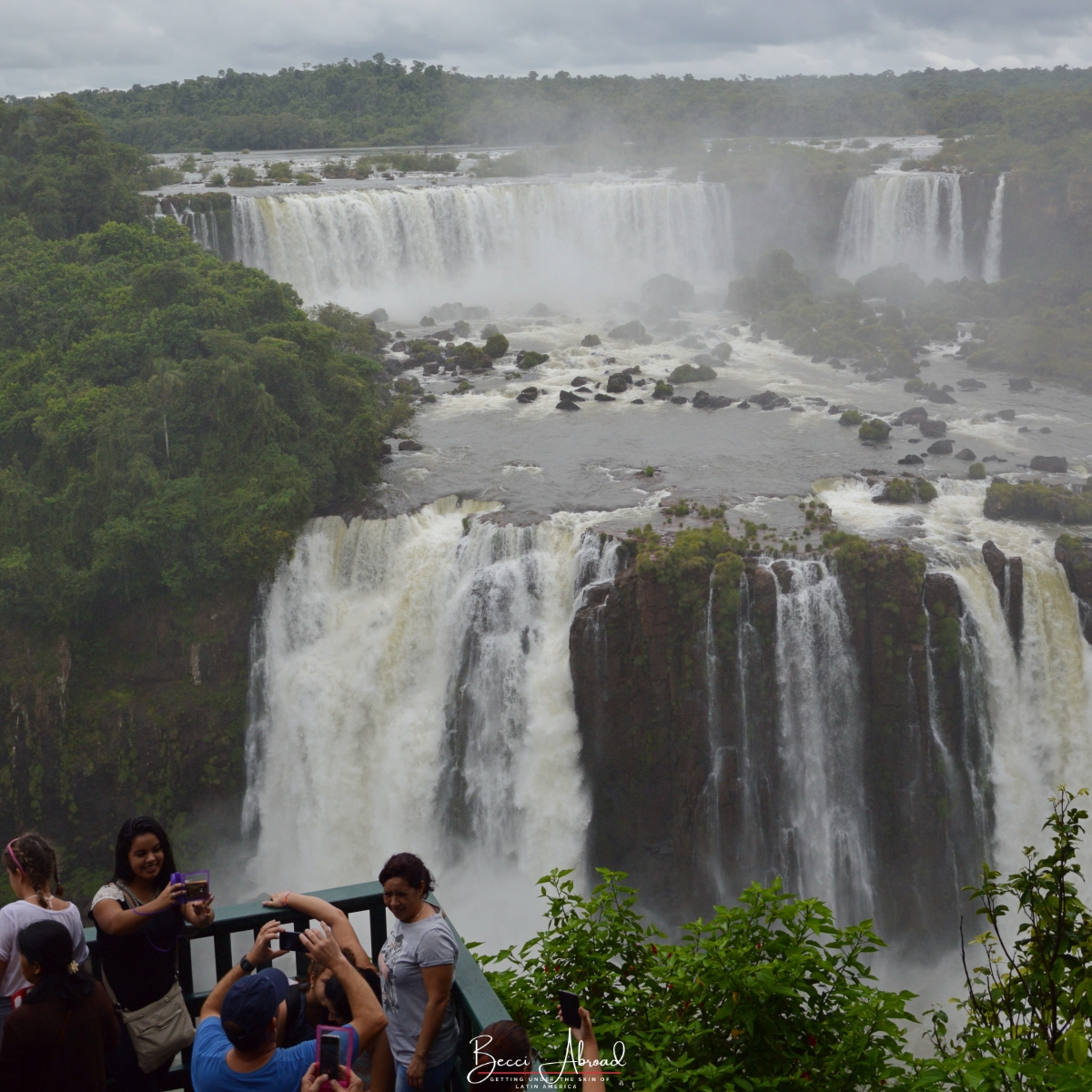
What Are the Iguazu Falls?
Iguazu Falls stands as a truly breathtaking natural wonder on our planet. Over 270 waterfalls make up the Iguazu Falls, forming the largest water system found anywhere in the world.
The Iguazu Falls stretch across a width of almost 3 kilometers on the Iguazu River and drop approximately 80 meters vertically. The falls are nearly three times wider than Niagara Falls on the U.S.-Canadian border.
The waterfalls were discovered in 1541 by the Spanish explorer Álvar Núñez Cabeza de Vaca. In 1984, the waterfalls were declared a UNESCO World Heritage site. They are a natural phenomenon created completely without interference from mankind.
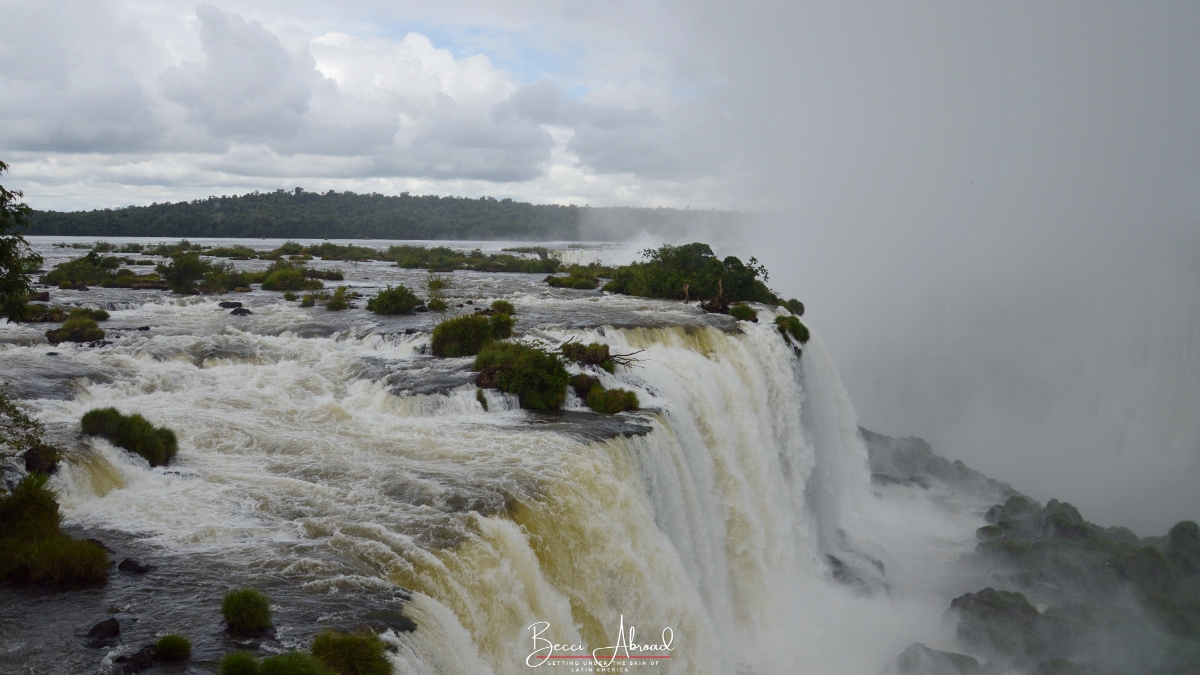
Where Are the Iguazu Falls Located?
The Iguazu Falls lies on the international border between Argentina and Brazil. In Argentina, the falls are called Cataratas de Iguazú in Spanish. While in Brazil, their Portuguese name is Cataratas do Iguaçu.
The Iguazu Falls are located within the Atlantic rainforest, covering parts of the province of Misiones in Argentina and parts of the state of Paraná in Brazil.
The Atlantic rainforest is not part of the Amazon rainforest, even though many people seem to believe that the Iguazu Falls are located in the Amazon Rainforest.


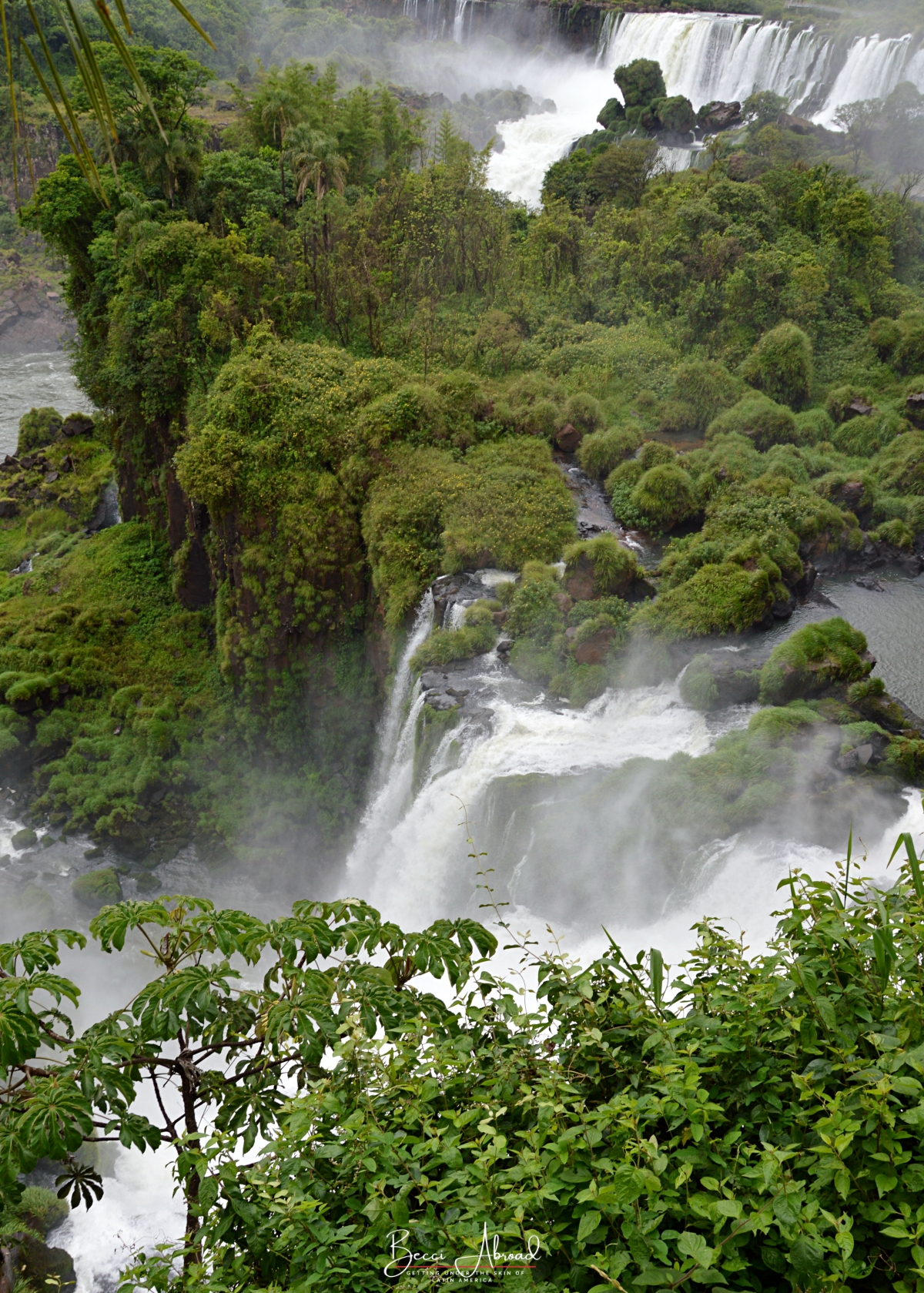
Planning Your Visit to the Iguazu Falls
Let’s look at some of the most important things to keep in mind when you plan your visit to the Iguazu Falls.
Argentina or Brazil? Which Side Is Best to Visit?
In my opinion, the best side to visit is the Argentine side! The Argentine side is more impressive and larger than the Brazilian side.
The Argentine side of the Iguazu Falls accounts for around 80% of the total falls. So, the national park in Argentina is a lot larger than the Brazilian one.
Since the majority of the falls are in Argentina, you can also get close to the falls and experience them from different angles when visiting from Argentina.
The views from the Brazilian side are more of a panoramic overview of the falls. From the Brazilian side, you are standing and looking over at the falls in Argentina.
If you are short on time and only have time for a one-day trip to the falls, I would choose to spend one day on the Argentine side of the Iguazu Falls.



How Long Do You Need to See the Iguazu Falls?
You can spend anywhere from one day to three days visiting the Iguazu Falls.
On the Argentine side, you can easily spend one or two full days exploring all the trails and circuits of the park in detail.
If you plan on visiting the Brazilian side of the Iguazu Falls, it will require a full day. The Brazilian side can be done within a couple of hours.
However, you need to factor in the time it takes to cross the Argentine-Brazilian border and reach the entrance of the Iguazu Park. Some tours offer an organized day trip to the Brazilian side of the falls.
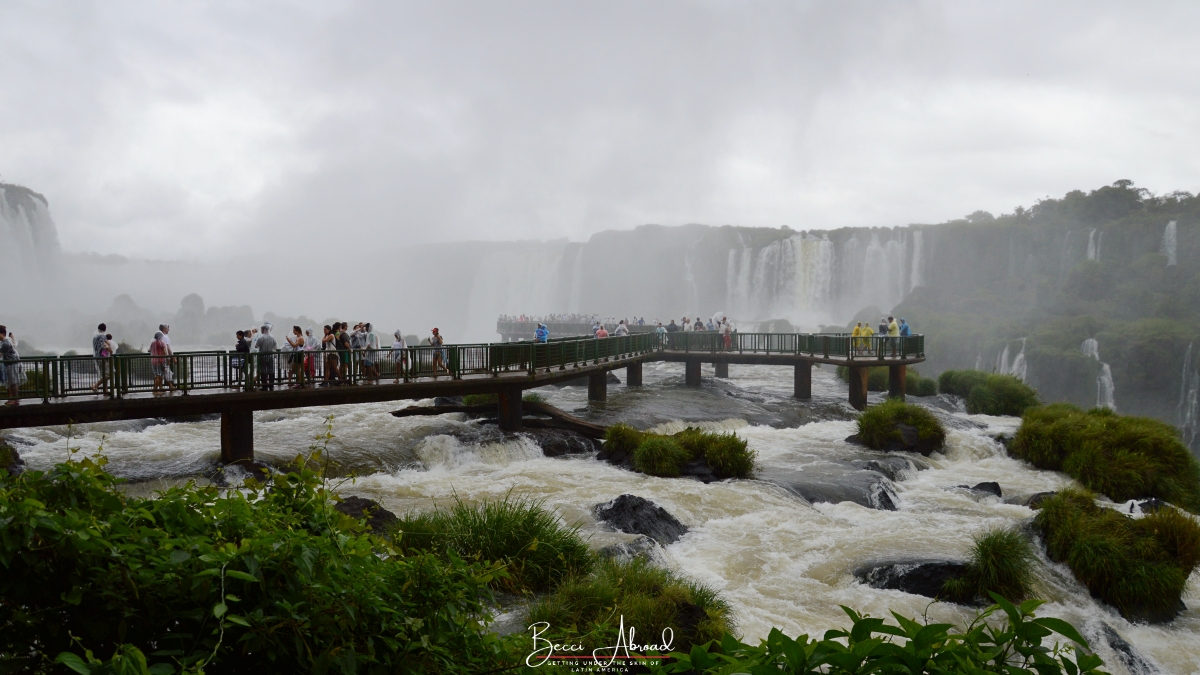

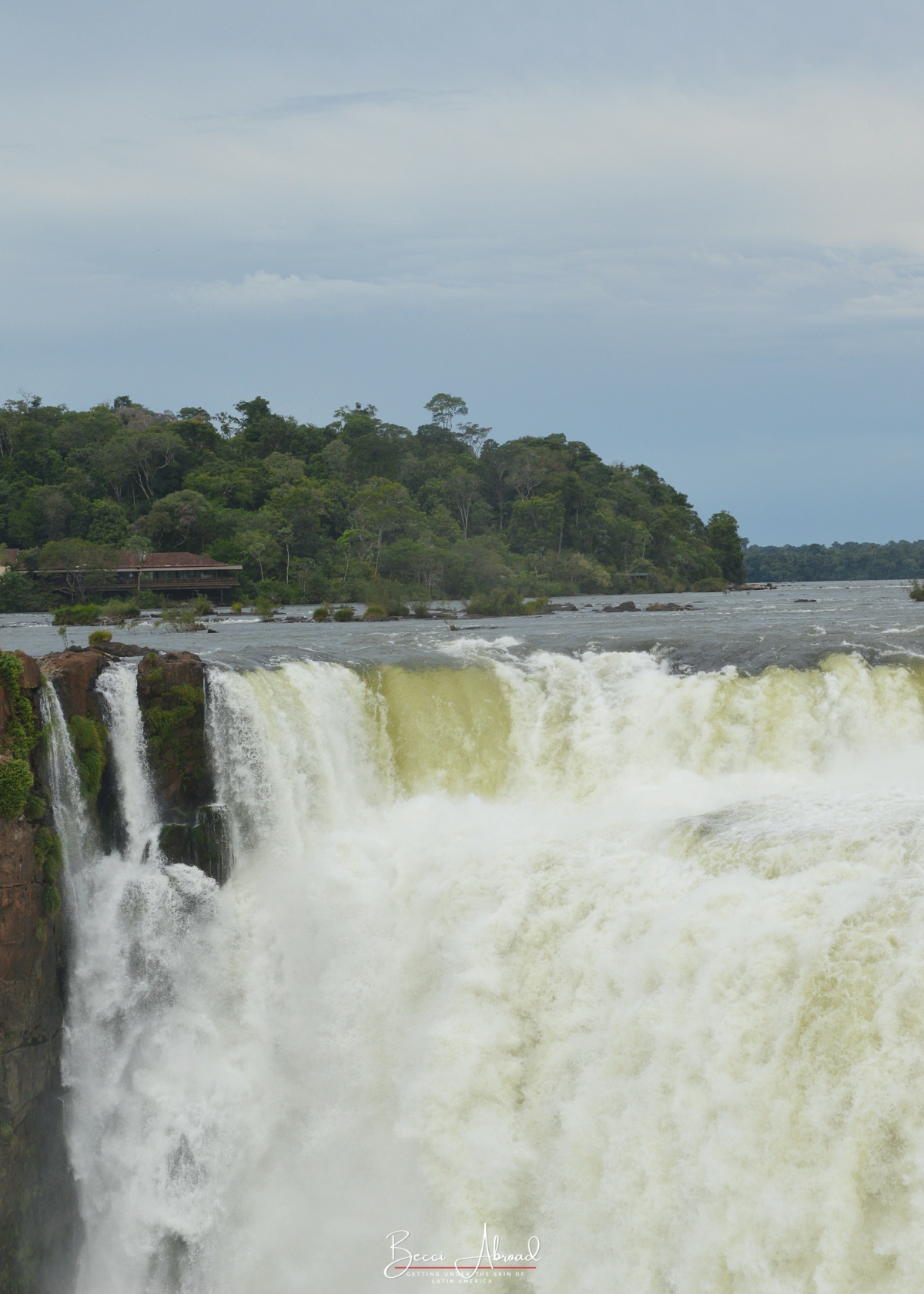

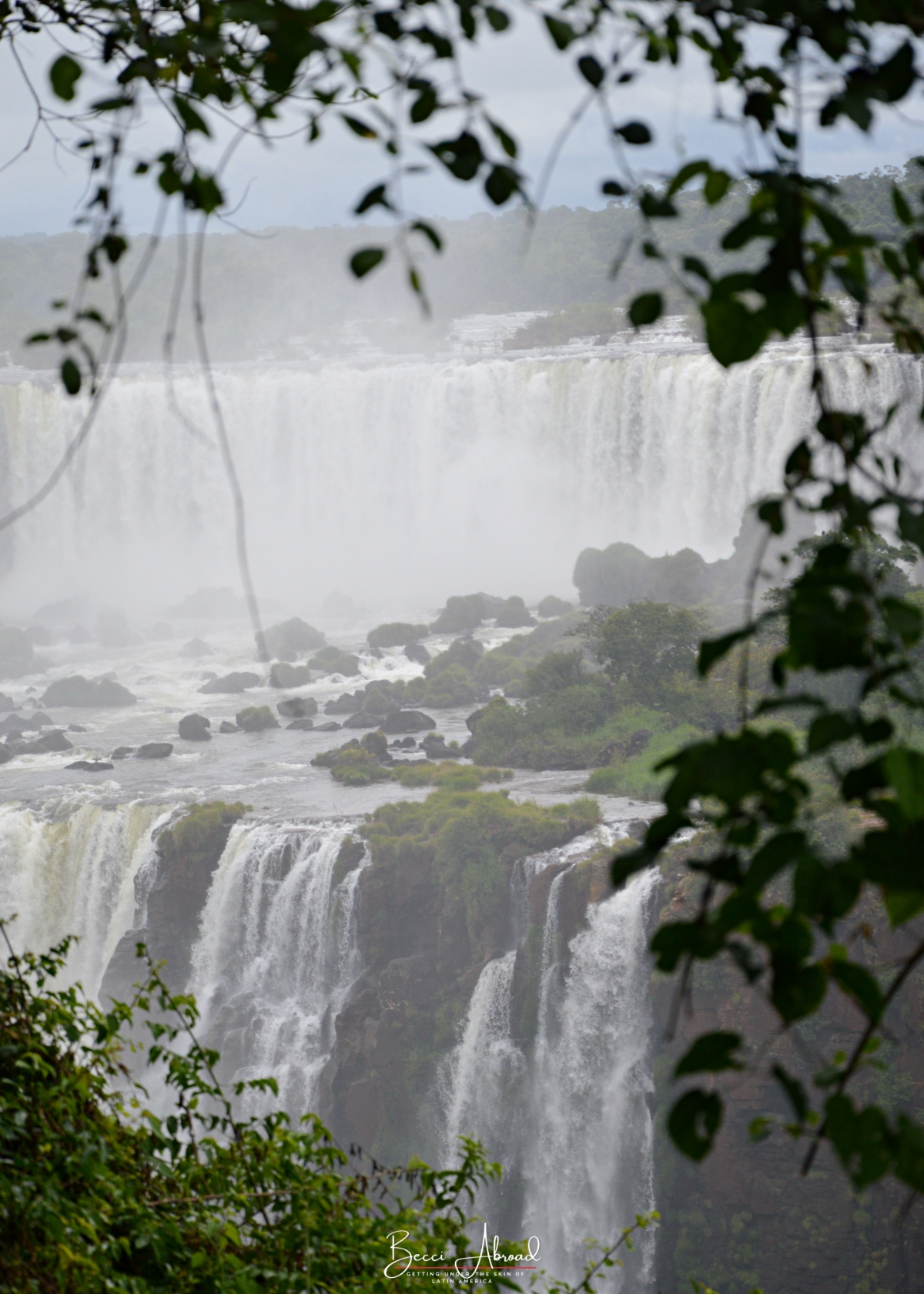



What Should Expect From Your Visit?
To be amazed!
You should expect to be awed and amazed! The Iguazu Falls are a natural wonder for a reason! There really isn’t anything that can prepare you for this experience.
Get soaked!
And you should expect to get soaked!
On either side of the Iguazu Falls, you get so close to the waterfalls that you are guaranteed to get soaked from the experience. So, prepare yourself, your camera, and your phone – or your electronics might end their days at Iguazu!
Pro-tip: A small plastic bag and some rubber bands can serve well as protection for your camera if you don’t want to spend money on a rain cover.
It’s safe!
You should not worry about getting lost or being eaten by dangerous animals, even though the falls are located inside a rainforest.
The parks have nicely paved trails and are properly signed. So, there is no risk of getting lost in the rainforest.
However, it is strongly recommended not to let children run around outside the marked trails as wild animals do live in the forest.
If any of the rainforest’s dangerous wildlife gets inside the park, the park administration immediately closes the park down. And trust me on this one! Because it is all over the national news in Argentina when it happens from time to time.
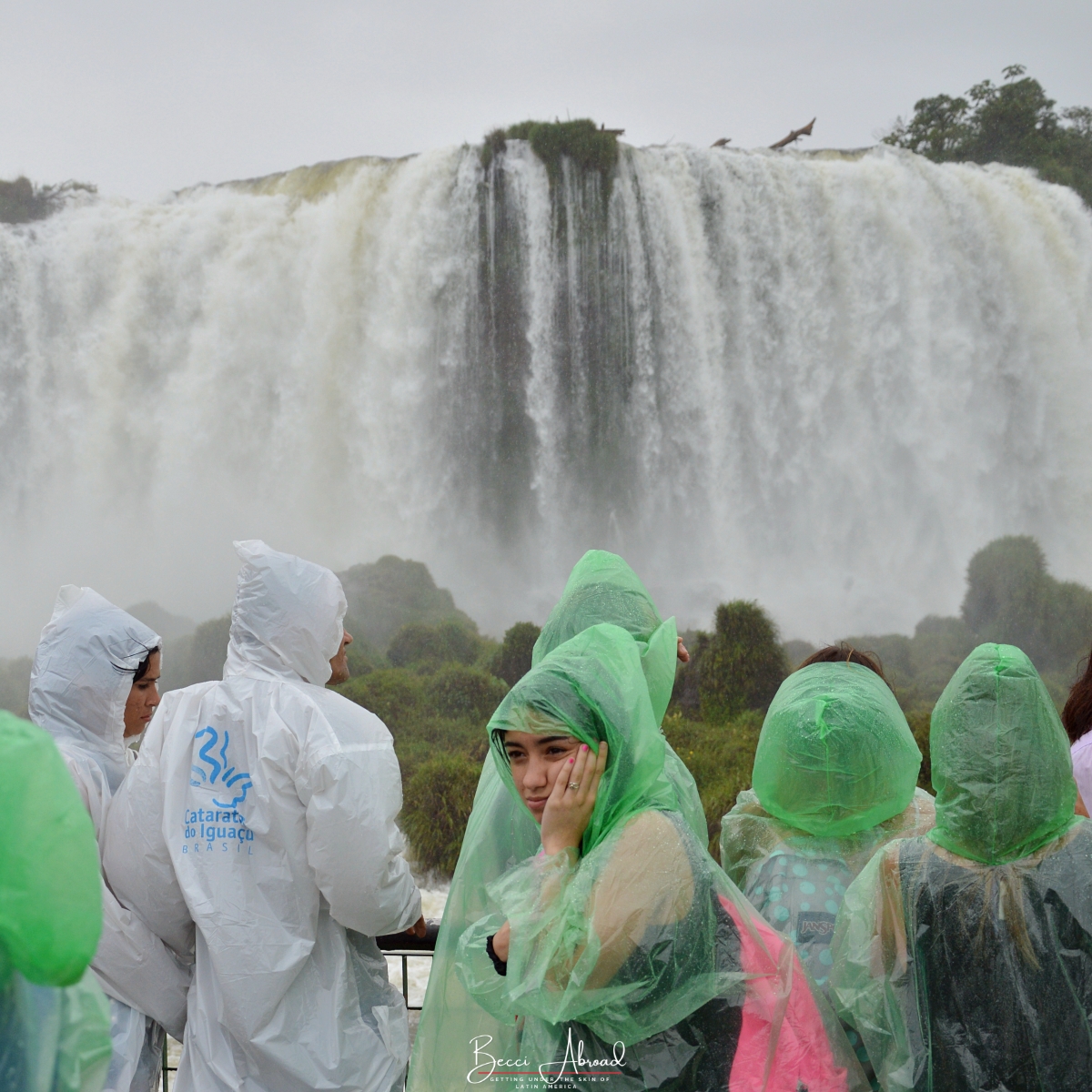



What Should You Bring for Your Trip?
For visiting Iguazu Falls, you should bring:
- Comfortable walking shoes (no hiking gear is needed)
- Comfortable and light clothes
- A raincoat or poncho (even though the weather forecast is clear)
- A rain cover for your backpack
- Waterproof protection for your camera and phone
- Snacks
- Water bottle
- Sun protection – sunscreen, sun hat, etc.
There are cafes, restaurants, and some small drugstores at the main spots in the park. But it is always good to bring some extra supplies with you in your bag for the long walks on the trails.


What to See and Do Inside the Iguazu Falls National Parks?
The Devil’s Throat
La Garganta del Diablo, translated as the Devil’s Throat, is the most popular spot on the Argentine side of the falls.
The trail you walk to get to the Devil’s Throat is a network of catwalks and bridges over the Iguazú River.
At the end, you come to the viewpoint right on the edge of the Devil’s Throat. It is impressive and scary at the same time… I really hoped that the bridge would hold!
I have heard people say that you should visit the Devil’s Throat as the last thing when you visit the Iguazu Falls. Otherwise, it will spoil the rest of the experience since nothing is as impressive as the Devil’s Throat.
However, we visited the Devil’s Throat as the first thing, and I don’t feel like it spoiled anything. The rest of the falls are just impressive in their own way afterward.
Closure of the Devil’s Throat
Back in 2022, the Devil’s Throat was closed for repairs. However, it reopened in March 2023.
The park administration sometimes closes the Devil’s Throat Circuit due to extreme weather or high water levels. They are usually good at updating their Instagram with closure updates. So, check out the Argentine Iguazu Park’s Instagram before going.






The Lower Circuit and the Upper Circuit in Argentina
In the Argentine Park, there are two main circuits to explore: a lower circuit and an upper circuit.
The upper circuit takes you to the top of the falls through catwalks and bridges. This circuit offers some impressive views of the falls. The upper circuit is the shorter of the two, spanning only about half a mile (0.8 km).
The lower circuit has several different viewpoints and trails and can easily take a couple of hours to explore. This circuit brings you closer to the falls, allowing you to truly grasp their magnitude.
On the lower circuit, you also have the access to the free ferry to San Martin Island – if the ferry is working! If water levels are too high, the ferry service isn’t available.
Read more about visiting the Argentine side without a guide here.






The Brazilian Circuit
On the Brazilian side, there is less space for exploration compared to the Argentine side of the falls.
There is only one main trail that everybody has to follow. The path quickly gets filled up with people and selfie sticks.
If you are short on time, there are tours to the Brazilian side. The tour takes you from the Argentine side to the Brazilian side on the same day.


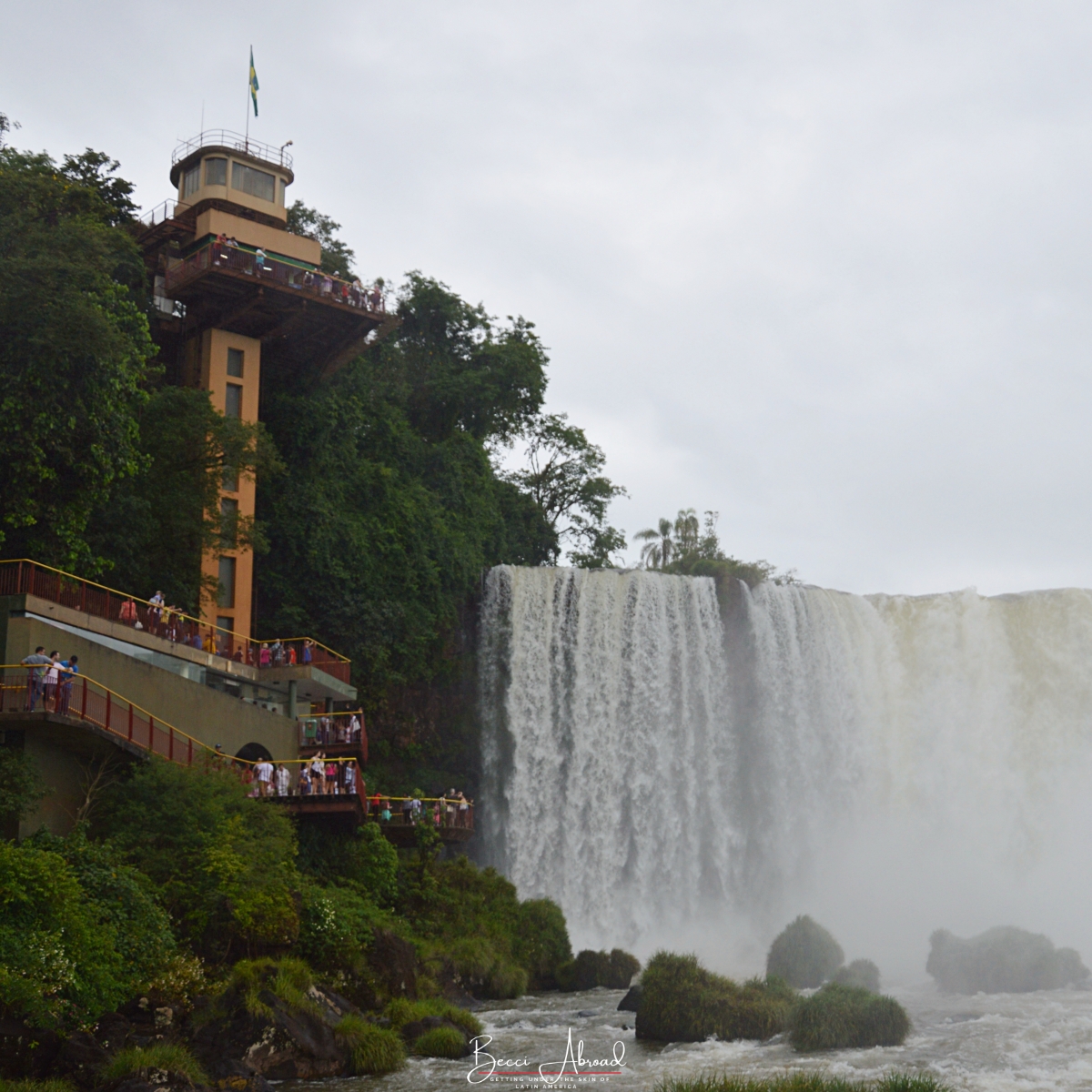



Boat tours on the Iguazu River
Different operators offer boat tours on the Iguazu River. Here, you get up close to the falls – and really soaked!
The boat tours are not included in the entrance ticket to either of the two parks. The tour must be purchased separately.
If you want the best experience, choose the Argentine side for your boat tour! Brazilian boats aren’t allowed to cross over the border to Argentina, and therefore, don’t get close to the falls.
If you plan on taking a boat tour, it’s a good idea to pack a dry set of clothes to bring with you.
Wildlife in the Iguazu Parks
The surrounding rainforest also offers many other unique wildlife experiences. Spot beautiful butterflies, maybe a monkey, or a caiman.
Keep your eyes and ears open!
The coatis
The coatis are small, very cute animals in the raccoon family that are native to South America. The Iguazu Park is filled with them, and they have become the second stars of the park with their cuteness!
However, even though they are cute, you should be careful around the coatis. The coatis will try to steal your food and might become aggressive in their attempts.
The parks are filled with signs advising not to pet the coatis. You should take these warnings seriously for your own safety. I was shocked to see how many people still tried to pet the coatis. The coatis are wild animals that might attack you! Feel free to take as many pictures as you want, but keep a distance from them.




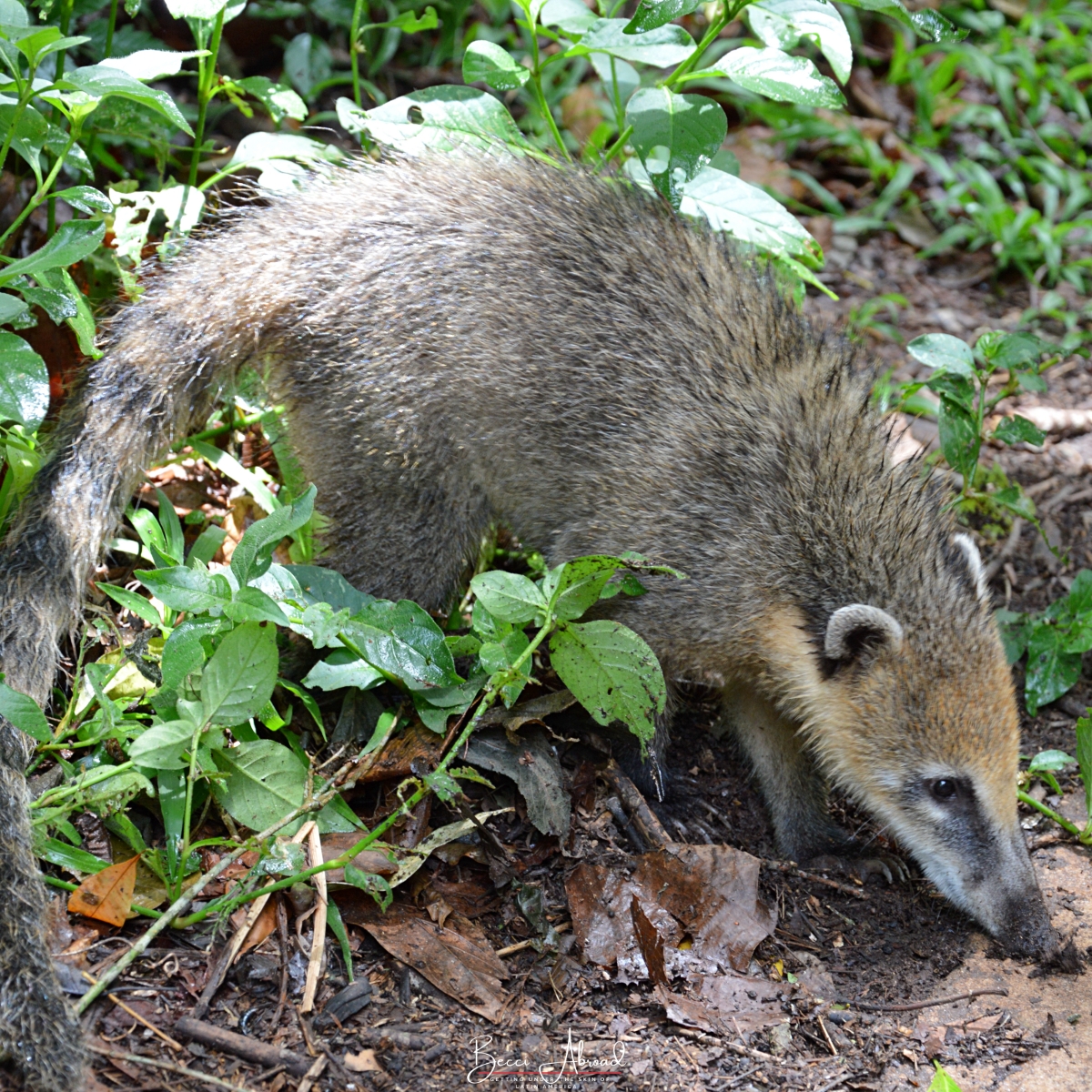



Other activities around the Iguazu Parks
There are several other interesting tours you can do around the Iguazu Parks:
- Helicopter Flight over the Iguazu Falls (Brazil/Argentina) – Fancy exploring the Iguazu Falls from above? A special experience is to do a helicopter ride over the falls.
- Iguazu Falls Bird Park, Parque das Aves (Brazil) – Across the road from the entrance to the Brazilian side, there is the Iguazu Bird Park. Here you can experience native bird species from the area.
- San Ignacio Ruins and the Wanda Mines (Argentina)– Visit the UNESCO-listed ruins of San Ignacio Miní, a 17th-century Jesuit mission nestled in the rainforest. In the Wanda Mines, you can explore below the surface and find precious stones like turquoise.
- City Tour and the Three Frontiers (Argentina) – The Argentine city of Puerto Iguazu offers some interesting sights such as the Three Frontiers Landmark between Argentina, Brazil, and Paraguay. Did you know that the city also has both a Buddhist Temple, a Catholic Cathedral, and a Mosque?
- La Lorenza Reserve (Argentina) – Experience a hidden gem of the Atlantic Rainforest, La Lorenza Reserve. The natural reserve is located in the middle of the rainforest and will give you a more authentic experience of the area.
- Horseback riding in the rainforest to the indigenous Guaraní Community (Argentina) – Explore and learn more about the rainforest’s flora and fauna and visit the local indigenous community, the Guaranis.
- Zip Line and Rappel Tour in the Rainforest (Argentina) – If you are looking to add some more adventure to your trip to Iguazu, then a zip line and rappel tour in the rainforest might be something for you!
- Shopping in Paraguay – Paraguay is known to be a shopaholic’s paradise in South America. The security in the country is questionable. So, if you want to go it is recommendable to do it with a tour guide.


How to Get Around Inside the Iguazu National Parks?
Inside the national parks, there are nicely paved trails to walk around and experience the natural park and the falls.
On the Argentine side, there is also a small train called Tren de la Selva or translated as the Jungle Train. The train takes people from the center of the park to the entrance of the trail to the main action of the falls, the Devil’s Throat.
On the Brazilian side, there are buses that take you from the main entrance to the entrance of the trail overlooking the falls.






When to Visit the Iguazu Falls?
You can visit the Iguazu Falls all year round! The national parks in both Argentina and Brazil are open all year round.
However, the best time to visit the Iguazu Falls is from late March to May or August to early October when it is winter and spring in the Southern Hemisphere.
The waterfalls might be less impressive during winter and spring due to lower water levels. However, the possibility of enjoying the falls with a blue sky and rainbows should also be higher.
The rainy season around Iguazu is from April through May and October through November. The Iguazu Falls will be more impressive during this time as the rainy season creates higher water levels. However, you are also at a higher risk of encountering heavy showers while visiting, speaking from experience!
The last part of December and January are peak vacation times in Argentina and Brazil. So, if you don’t want even more visitors and the possibility of being overwhelmed by Argentine or Brazilian families, try to avoid this time of the year.
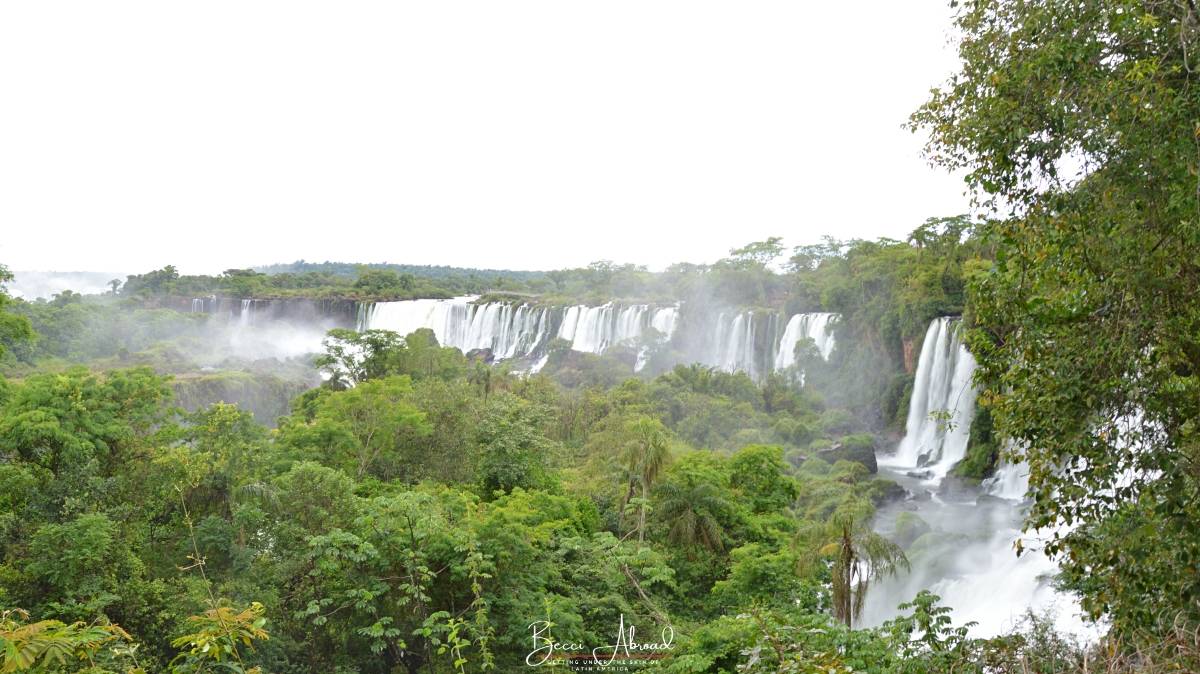

How Much Does It Cost to Visit the Iguazu Falls?
Prices for the Iguazu National Park in Argentina
The entrance prices for the Iguazu National Park in Argentina change constantly due to the high inflation rates in Argentina. Always check the current prices on the park’s website!
You can buy your ticket to Iguazu online.
Your ticket includes access to all the walking paths surrounding the falls, including both the upper circuit, lower circuit, and the circuit to the Devil’s Throat. It also includes the use of the Tren de la Selva train to get to the Devil’s Throat.
And if you are lucky (we were not), the ticket price also includes a trip with the ferry over to San Martin Island, located in the middle of the Iguazu River.
On the Argentine side, you can get a 50% discount on your second day’s visit. It is important to get your ticket stamped in the ticket office upon leaving after your first day in the park to obtain the discount on the second day.
The Iguazu National Park in Argentina is open every day from 8 am to 6 pm. The last entrance to the park is at 4:30 pm.
Prices for the Iguazu National Park in Brazil
The entrance price for the Iguazu National Park in Brazil is R$83 Brazilian Real at the moment. Always remember to double-check current prices on the park’s website.
You can book the tickets in advance online.
Both parks offer considerable discounts if you are a resident of a MERCOSUR country or a resident of their respective countries. This also includes foreigners with valid residency cards in Argentina or Brazil.




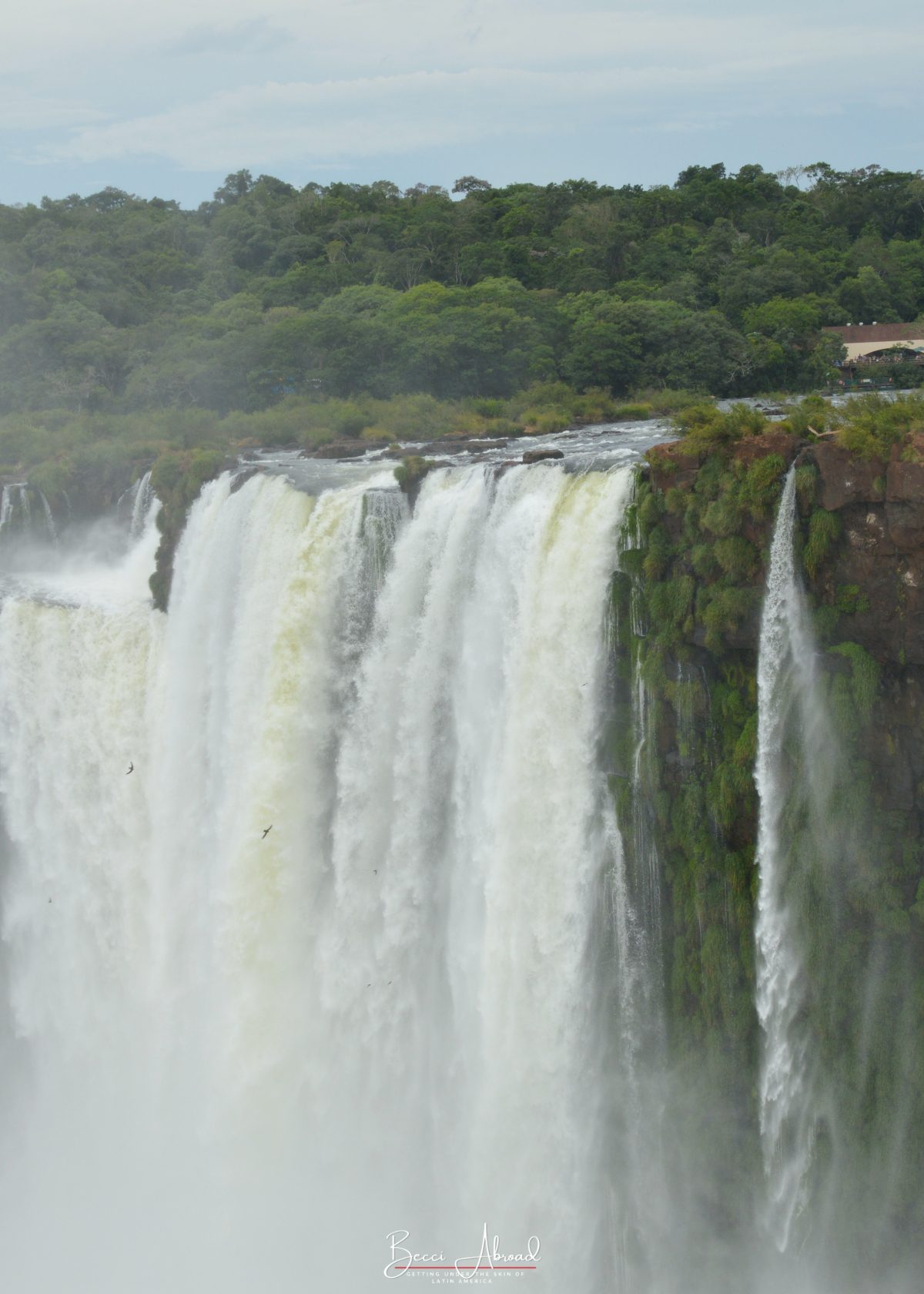

Do You Need a Visa to Visit the Iguazu Falls?
Depending on your nationality, you might need a visa for either Argentina or Brazil – or both.
This is especially important to remember if you want to visit both sides of the Iguazu Falls since you will need to cross the international border between Brazil and Argentina to visit both sides.
There is no visa exemption for visitors to the Iguazu Falls – even if you are just in and out on the same day. You still need to meet the visa requirements.
- Check the list of countries that need a visa to enter Brazil.
- Check the list of countries that do NOT need a visa for Argentina. If your country is not on this list, contact the Argentine embassy in your home country to learn more about the visa requirements.






Transportation to Iguazu National Parks in Argentina and Brazil
The Iguazu Falls are located inside a national park in both Argentina and Brazil. In Argentina, the national park is called Parque Nacional Iguazú, while in Brazil, the park is called Parque Nacional do Iguaçu.
Argentina
In Argentina, the closest city to the falls is Puerto Iguazú. The city of Puerto de Iguazú is located quite far from the entrance to the Iguazu National Park.
The bus company Río Uruguay runs a bus from Puerto de Iguazú to the entrance of the Iguazu Park. The easiest place to catch the bus from Puerto de Iguazú is from the bus station (estación de ómnibus).
You can also take a taxi from your accommodation to the entrance. Ask the receptionist of your hotel to call a taxi for you.
Brazil
In Brazil, the closest city to the falls is called Foz do Iguaçu. Foz do Iguaçu is also located quite far from the entrance to the Iguazu National Park.
There are public buses that can take you to the entrance of the park on the Brazilian side, or you can opt for a taxi.
How to Get to the Iguazu Falls?
When you plan your trip and book your tickets to visit the Iguazu Falls, keep in mind that the two cities closest to the falls have very similar names but are located in two different countries:
- Puerto de Iguazú is in Argentina.
- Foz do Iguaçu is in Brazil.
It is usually more economical to travel domestically within the same country. So, if you are visiting Argentina, look for tickets to the Argentine side of the falls, Puerto de Iguazú. And vice versa if you come from Brazil.
How to Get to Puerto de Iguazú from Buenos Aires?
- By Bus: To get to the Iguazu Falls from Buenos Aires or any other major cities in Argentina, you can take a long-distance bus to Puerto de Iguazú. The bus journey from Buenos Aires to Puerto de Iguazú takes close to 20 hours! You can check the current prices and schedule at BusBud in Argentina.
- By Plane: From Buenos Aires, there are regular flight connections to Puerto de Iguazú. Check Aerolíneas Argentinas or the local low-cost airline, Flybondi.
Flybondi might be cheaper than Aerolíneas Argentinas, but keep in mind that they might charge you extra for luggage, etc. – like any other low-cost airline.
How to Get to Foz do Iguaçu from Within Brazil?
- By Bus: From most major cities in Brazil, you can take a long-distance bus to Foz do Iguaçu. Check current prices and schedules for buses in Brazil.
- By Plane: There are flight connections from the major Brazilian cities to Foz do Iguaçu.


Is It Possible to Do the Iguazu Falls as a Day Trip from Buenos Aires?
The flight from Buenos Aires to Puerto de Iguazú is only just about 2 hours. So, technically could you visit to the Iguazu Falls as a day trip from Buenos Aires.
You would properly be a little bit short on time to see everything.
However, it is possible, and there are even tour companies that offer special tours where they organize the whole day trip for you.
This might be a good idea if you are short on time and want to fit the Iguazu Falls into your Argentina trip.
Have you visited the Iguazu Falls? Would you like to visit? Or maybe you are already planning a trip here? Share your thoughts and knowledge below!
Enjoyed the post? Pin it!










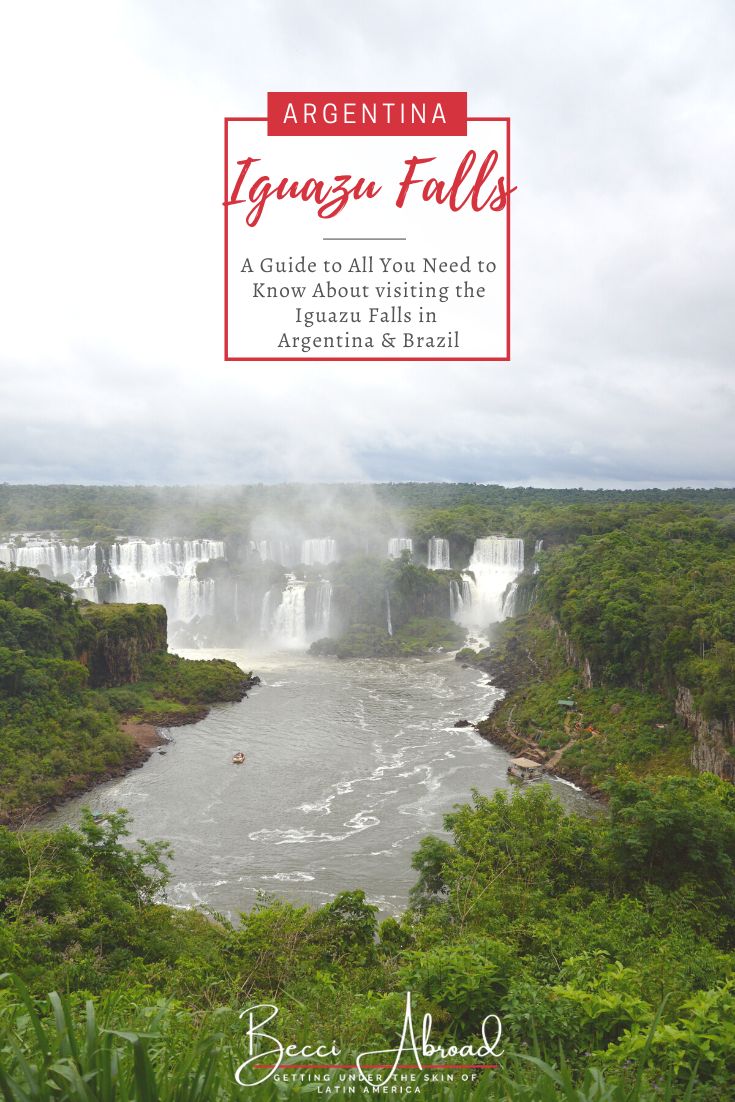
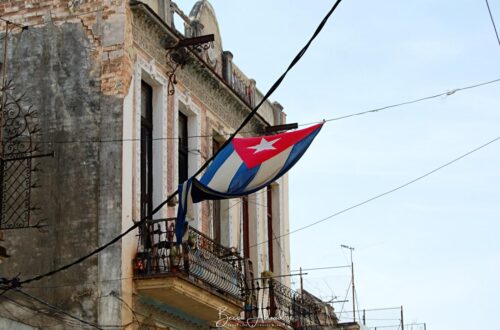
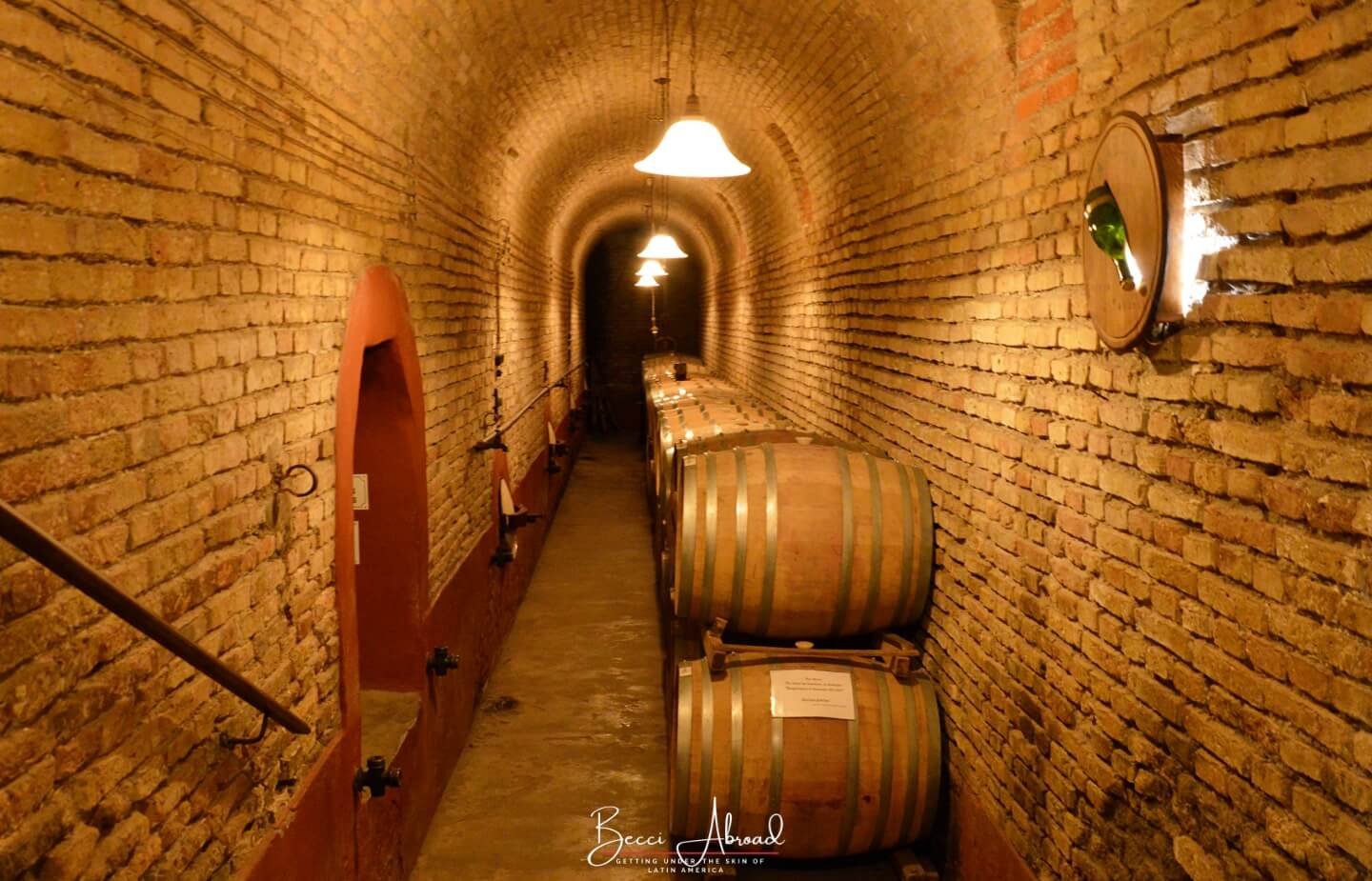
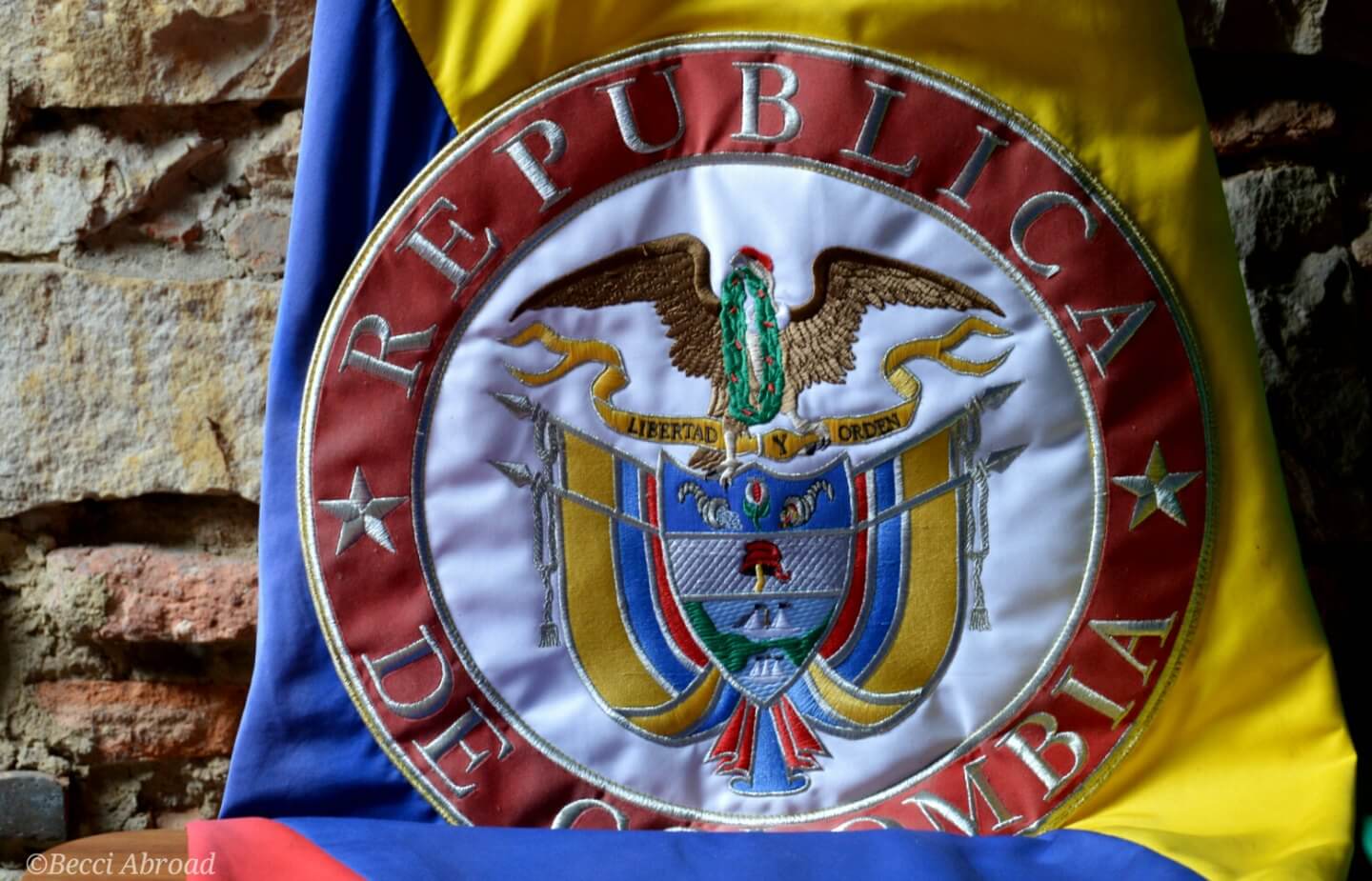
20 Comments
Lindsey
This is awesome advice! I’m team Argentine side as well. 😉 Haha. We ran right to Devil’s Throat too – but still thought everything else was impressive too! Good idea with how you protected your camera as well. I can’t believe how you soaked you get!
Rebecca
Thanks for dropping by, Lindsey! Yeah, team Argentina 😉 Good to hear that we weren’t the only ones to take the Devil’s Throat first. And yes, the fall are truely amazing!
Zara
Some great tips here. Can’t believe there are 270 waterfalls…amazing!
Rebecca
Thank you so much, Zara! I’m happy to hear that you enjoyed the reading 🙂
Mayuri
What a detailed post! Love you have highlighted and included everything to travel to and enjoy the beautiful falls. Argentina is on my bucket list and I will definitely refer to this post when I travel
Thanks for sharing
Rebecca
Thanks for dropping by, Mayuri! I’m so happy to hear that you found the post helpful! I hope that you’ll be able to make it to Argentina soon. It is a beautiful country!
Erin
No such thing as too many posts out there about Iguazu. I love it there! I also prefer the Argentine side, we didn’t have time to go to the Parque Das Aves, looks awesome!
Rebecca
Thank you, Erin!! 🙂 So true! It is really an amazing place! You should certainly check out Parque das Aves if you go come! There were so many beautiful birds.
Daniela
You took a lot of great coati photos. I have to admit that I was tempted to pet them because they came so close and looked absolutely harmless. I’m usually not the type to recommend must-see places but Iguazú is really a must and I haven’t met anyone who regretted their visit. And yes, the Argentine side is much better.
Rebecca
Thank you so much, Daniela! 🙂 Yeah, I know, I also really wanted to try petting whose sweet coatis… But looked at the pictures on the signs, and thought that better not try my luck with them 😉
I’m so happy to hear that you also enjoyed your visit there. It is a very well-organized area which at some points reminded me of an amusement park but the falls are so spectacular that I can survive the amusement park-feeling 😉 Thanks for dropping by the blog :*
Steven & Jenny
We love this article format. So nice to read and very informative! We felt like we were back there.
Bente Hoffmann * Bentes rejser
Thank you for taking me back to Iguazu – I’m a fan of the Argetine side too 😉
After having revisited Iguazu in December 2017 between Christmas and New Year my best advice is: Do not go there at that time of year! It was terribly crowded – much worse than when you and I went there in mid-December.
Esmeralda
Hi! I plan on going to Iguazu falls soon with my husband and kids. Is there anything else to do around there besides the falls?? I have seen post about the 3 borders. I would like to make the best of our time there!! Thanks.
Rebecca
Hi Esmeralda! I’m so happy to hear that you found the post useful! I didn’t do the 3 borders, so I have any idea what’s like. However, what I really liked on the Brazilian side was visiting the Bird Park (Parque das Aves: http://www.parquedasaves.com.br/en/) – maybe that’s something for your kids too 🙂
Enjoy your trip!
Rebecca
Wow, this is beautiful, and very informative! Your pictures are always great (what kind of camera do you like to use?), and your posts always give a great overview, thank you! It’s great to learn about a place from someone who has actually experienced it, first-hand!
Rebecca
Thank you so much, Rebecca! I’m really pleased to hear that you enjoy my writing – means the world when one puts many hours into it 🙂 I use a Nikon D3200 camera. It is great, and I could surely learn a lot more about how to use it better 😉
William R. Parks
Wow – such stunning scenery! 270 waterfalls, making crazy ! Thank you for this awesome post.
Rebecca
Thank you so much! I’m so happy to hear that you enjoyed the read! 🙂
Eric Gamble
Awesome guide to info I need to know when I cross off Iguazu Falls from my bucket list project. I have been researching it for 2019 and love all the info. Great tips on bringing rain coats and cover for your cameras or phones. I would totally be that guy soaked in my tshirt and shorts! Wonder why it is about $3 USD more to enter from the Brazilian side when there is more on the Argentinian side? Bizarre!
Love the pics of the animals especially the Coatis but I bet they are pretty aggressive and shouldn’t be messed with. Thanks for all the ticket and bus info. Was trying to do this without an official tour group if possible so the info is great!
Rebecca
Hi there Eric,
Thank you so much for dropping by my blog and I’m so deeply apologise for the late reply!
I’m so SO happy to hear that you found the post useful for planning your trip to Iguazu! That was exactly the idea with it 🙂
Haha, yeah, it’s crazy that the Brazilian side is more expensive than the Argentine. However, if you are planning to visit in 2019, I would highly recommend that you double check the price for the Argentine (and maybe also the Brazilian side) before going. Argentina has experienced quiet a wild economic year, so prices might have change quiet a bit.
I hope you get an amazing trip to Iguazu without getting completely soaked!
Abrazos Becci